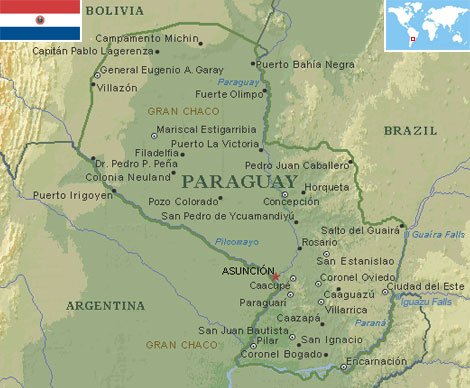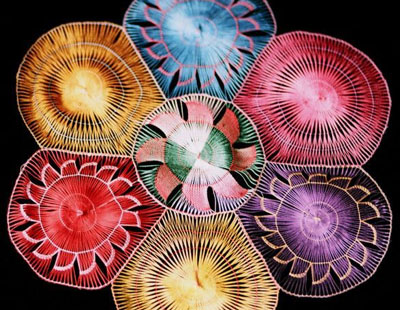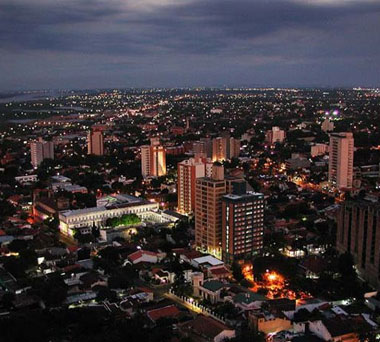Paraguay
Country statistics

Land area: 153,398 sq miles (397,301 sq km)
Total area: 157,046 sq miles (406,750 sq km)
Population (2011 est.): 6,541,591 (growth rate: 1.256%); birth rate: 17.22/1000; infant mortality rate: 22.24/1000; life expectancy: 76.4; density per sq miles: 39
Capital City: Asunción
Monetary unit: Guaraní
Languages: Spanish, Guaraní (both official)
Ethnicity/race: mestizo 95%
Religions: Roman Catholic 90%, Mennonite, other Protestant 6.2%
Country introduction

Paraguay is a landlocked country in South America. It is bordered by Argentina to the south and south-west, Brazil to the east and north-east, and Bolivia to the north-west. Paraguay lies on both banks of the Paraguay River, which runs through the center of the country from north to south. Due to its central location in South America, it is sometimes referred to as Corazón de América, or the Heart of America.
The natural environment of Paraguay is one of the most diverse in the world. From green grasslands, to thorny forests and palm savannas, the country is an exciting blend of natural beauty. It is also a land that still holds untouched wildernesses much like the first explorers witnessed.
The country can be divided into two major regions. There is the eastern region, officially called Eastern Paraguay (Paraguay Oriental) and known as the Paraneña region, and the western region, officially Western Paraguay (Paraguay Occidental) and known as the Chaco.
The Paraneña, east of the Paraquay River, is a fertile, cultivated landscape, with rolling hills, low mountains and subtropical forests. The region has numerous streams and lakes and dense tropical forests that are abundant with wildlife. The eastern region is where 95% of the population live and the majority of the towns and cities located here still display the countries pioneer and colonial traits in the local architecture.
To the west of the Paraguay River, the hot scrub lands and low plains of the Gran Chaco cover about 60% of Paraguay's total land area. This region of the country is by far the largest area, but also the least populated. It's a vast, mostly infertile tract of land that experiences a wet and dry climate. Areas of land that are deserts throughout the winter months, become swamp lands during the summer rains. Some of the highest temperatures on the planet have been recorded in this region.
The culture

Paraguay owes its diverse culture to the mixture of traditional Spanish culture with the native Guaraní culture (the dominant ethnic group in the area). Due to the intermarriage of these two cultures, Paraguay is a bilingual country, with approximately 90% of its population speaking Spanish and Indian called Guaraní. This historical process resulted in the creation of the mestizo culture, which blends elements from both cultures.
Paraguayans are very expressive people and their artistry speak of their culture. The most common art form for the ladies is embroidery and lace-making. Lace-making, called "nanduti", is particularly an important tradition, which is thought to represent a combination of 16th-century needle lace-making techniques from Europe with Guaraní traditions. Men, on the other hand, who have Spanish blood in their veins, are good musicians. The typical instruments include native harps and guitars, and the songs are mostly polkas and galopas. Paraguay is also known for its filigree jewellery whether made in gold or silver, and the best place to find them is in the city of Luque, in the outskirts of Asunción and the many jewellery shops across the country. The Guaranis also specialized in ceramic designs, and created objects such as funerary urns and jugs used for drinking.
The months between February and July mark Paraguay's carnival season, with the biggest being the Fiestas of San Blas in February. San Blas is the patron saint of the country and the festival is marked with various performances of polka dance and tabloid displays. The carnival of Nirgen de la Candelaria is a special attraction for tourists held from the 2nd till 14th February. The month of March celebrates the festival of Semanta Santa, which has a religious connection and is observed with great solemnity. Festival de San Juan or the festival of San Juan takes place on the 24th of June and includes rituals like walking on hot coals, fire walking and the burning of an effigy of Judas Iscariot. The last festival namely, Festival del Nanduti, takes place in the month of July. It is a traditional fair where one can observe and shop around for handicrafts and traditional stuff.
Paraguayans are fond of sports. While football (soccer) is the most popular sport, fishing, tennis, basketball, and golf are also common. The annual Transchaco Rally, a three-day motor rally covering thousands of miles of dirt roads of the sparsely populated Paraguayan Chaco, is held in September. Paraguay made its Olympic debut at the 1968 Games in Mexico City.
Attractions & landmarks

Paraguay is well known for its huge number of tourist attractions, and is an appropriate destination for spending a long, relaxing and enjoyable vacation.
One of the great natural wonders of the world, the Iguazu Falls is a top destination for visitors to Paraguay. The massive pouring of the falls against the lush green forests is a spectacular sight to behold. There are 275 individual cascades, with the highest fall dropping almost 82 m (270 ft). The fall itself is located between Brazil and Argentina, but are easily accessible from the city of Ciudad del Este in Paraguay, a city mainly known as a shopping destination. It is also close to the Itaipú Dam, the largest operating hydroelectric facility in terms of annual energy generation.
Asunción the capital and largest city of Paraguay is an interesting place to visit with much of the historical section, including the charming colonial buildings and plazas situated near the Paraguay River. The "Manzana de la Rivera", located in front of the Presidential Palace, is a series of old traditional homes that have been restored and serve as a museum showcasing the architectural evolution of the city. The old railway station maintains the old trains that are now used in tourist trips to the cities of Luque and Areguá. The city is also home to the Godoi Museum, the Museo Nacional de Bellas Artes (which contains old paintings from the 19th century), the Church of La Encarnación, the Metropolitan Cathedral and the National Pantheon of the Heroes, a smaller version of Les Invalides in Paris, where many of the nation's heroes are entombed. Other landmarks include the Palacio de los López, the old Senate building (a modern building opened to house Congress in 2003) and the Casa de la Independencia (one of the few examples of colonial architecture remaining in the city).

The city of Encarnación is considered the Carnival Capital of Paraguay, as the biggest carnival is held here in February featuring mainly Brazilian music and dance. The year-round festive ambience and colorful costumes lend it a unique appeal that tourist find inviting. The city is also located near the sill preserved Jesús and Trinidad Jesuit Ruins, which are religious missions that were founded by the Jesuit missioners during the colonization of South America in the 17th century. The Menno Colonies in Hohenau, Obligado and Bella Vista offer an insight into the history of the Germans who came to Paraguay for religious reasons. A little outside Encarnación is Manantial, a private reserve, which is ideal for horse riding, tracking and camping. Fishing in the Paraná River is also a popular activity.
Villarrica is considered the "Cultured City" of Paraguay and historically it is nicknamed "La Andariega", or "keen on walking", as it has changed its location several times. With a rich history and noteworthy academic and cultural activity, it is stately and hospitable. It has diverse nearby attractions, such as the beautiful town of Yataity, where they make the delicate handicraft of Ao Po'I, and the German colonies where delicious wines and other quality products are produced.